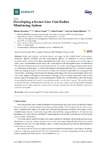Mostrar o rexistro simple do ítem
Developing a Secure Low-Cost Radon Monitoring System
| dc.contributor.author | Alvarellos, Alberto | |
| dc.contributor.author | Gestal, M. | |
| dc.contributor.author | Dorado, Julián | |
| dc.contributor.author | Rabuñal, Juan R. | |
| dc.date.accessioned | 2020-03-04T15:34:18Z | |
| dc.date.available | 2020-03-04T15:34:18Z | |
| dc.date.issued | 2020-01-29 | |
| dc.identifier.citation | Alvarellos, A.; Gestal, M.; Dorado, J.; Rabuñal, J.R. Developing a Secure Low-Cost Radon Monitoring System. Sensors 2020, 20, 752. https://doi.org/10.3390/s20030752 | es_ES |
| dc.identifier.issn | 1424-8220 | |
| dc.identifier.issn | 1424-8239 | |
| dc.identifier.uri | http://hdl.handle.net/2183/25110 | |
| dc.description.abstract | [Abstract] Radon gas has been declared a human carcinogen by the United States Environmental Protection Agency (USEPA) and the International Agency for Research on Cancer (IARC). Several studies carried out in Spain highlighted the high radon concentrations in several regions, with Galicia (northwestern Spain) being one of the regions with the highest radon concentrations. The objective of this work was to create a safe and low-cost radon monitoring and alert system, based on open source technologies. To achieve this objective, the system uses devices, a collection of sensors with a processing unit and a communication module, and a backend, responsible for managing all the information, predicting radon levels and issuing alerts using open source technologies. Security is one of the largest challenges for the internet of things, and it is utterly important in the current scenario, given that high radon concentrations pose a health risk. For this reason, this work focuses on securing the entire end-to-end communication path to avoid data forging. The results of this work indicate that the development of a low-cost, yet secured, radon monitoring system is feasible, allowing one to create a network of sensors that can help mitigate the health hazards that high radon concentrations pose. | es_ES |
| dc.description.sponsorship | This project was funded by the Consolidation and Structuring of Competitive Research Units-Competitive Reference Groups (ED431C 2018/49) and Accreditation, Structuring, and Improvement of Consolidated Research Units and Singular Centers (ED431G/01), funded by the Ministry of Education, University and Vocational Training of the Xunta de Galicia endowed with EU FEDER funds. This research was supported by the Spanish Ministry of Economy, Industry and Competitiveness, R & D National Plan, via the project BIA2017-86738-R. This research and the APC were also supported by Instituto de Salud Carlos III, grant number PI17/01826 (Collaborative Project in Genomic Data Integration (CICLOGEN) funded by the Instituto de Salud Carlos III from the Spanish National plan for Scientific and Technical Research and Innovation 2013–2016 and the European Regional Development Funds (FEDER)—“A way to build Europe.”. This project was also supported by the General Directorate of Culture, Education and University Management of Xunta de Galicia ED431D 2017/16 and “Drug Discovery Galician Network” Ref. ED431G/01 and the “Galician Network for Colorectal Cancer Research” (Ref. ED431D 2017/23), and finally by the Spanish Ministry of Economy and Competitiveness through the funding of the unique installation BIOCAI (UNLC08-1E-002, UNLC13-13-3503) and the European Regional Development Funds (FEDER) by the European Union | es_ES |
| dc.description.sponsorship | Xunta de Galicia; ED431G/01 | es_ES |
| dc.description.sponsorship | Xunta de Galicia; ED431C 2018/49 | |
| dc.description.sponsorship | Xunta de Galicia; ED431D 2017/16 | |
| dc.description.sponsorship | Xunta de Galicia; ED431D 2017/23 | |
| dc.language.iso | eng | es_ES |
| dc.publisher | MDPI AG | es_ES |
| dc.relation | info:eu-repo/grantAgreement/AEI/Plan Estatal de Investigación Científica y Técnica y de Innovación 2017-2020/BIA2017-86738-R/ES/SISTEMA PARA LA OPTIMIZACION DE LA OPERATIVIDAD PORTUARIA MEDIANTE EL ANALISIS DINAMICO DE BUQUE AMARRADO Y CLIMA MARITIMO, CON TRABAJO DE CAMPO Y ENSAYOS EN MODELO FISICO | |
| dc.relation | info:eu-repo/grantAgreement/ISCIII/Plan Estatal de Investigación Científica y Técnica y de Innovación 2013–2016/PI17%2F01826/ES/PROYECTO COLABORATIVO DE INTEGRACION DE DATOS GENOMICOS (CICLOGEN). TECNICAS DE DATA MINING Y DOCKING MOLECULAR PARA ANALISIS DE DATOS INTEGRATIVOS EN CANCER DE COLON/ | |
| dc.relation | info:eu-repo/grantAgreement/MEC/Plan Nacional de I+D+i 2008-2011/UNLC08-1E-002/ES/Infraestructura computacional para la Red Gallega de Bioinformática | |
| dc.relation | info:eu-repo/grantAgreement/MINECO/Plan Estatal de Investigación Científica y Técnica y de Innovación 2013-2016/UNLC13-1E-2503/ES/Plataforma HPC-PLUS para aplicaciones biomédicas | |
| dc.relation.uri | https://doi.org/10.3390/s20030752 | es_ES |
| dc.rights | Atribución 4.0 Internacional | es_ES |
| dc.rights.uri | http://creativecommons.org/licenses/by/4.0/ | * |
| dc.subject | Radon monitoring | es_ES |
| dc.subject | IoT security | es_ES |
| dc.subject | Alert system | es_ES |
| dc.subject | Open source | es_ES |
| dc.title | Developing a Secure Low-Cost Radon Monitoring System | es_ES |
| dc.type | info:eu-repo/semantics/article | es_ES |
| dc.rights.access | info:eu-repo/semantics/openAccess | es_ES |
| UDC.journalTitle | Sensors | es_ES |
| UDC.volume | 20 | es_ES |
| UDC.issue | 3 | es_ES |
| UDC.startPage | 752 | es_ES |
| dc.identifier.doi | 10.3390/s20030752 |
Ficheiros no ítem
Este ítem aparece na(s) seguinte(s) colección(s)
-
GI-RNASA - Artigos [193]






